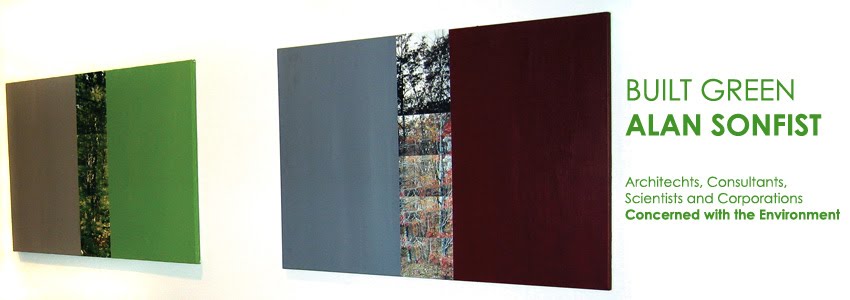Thursday, August 25, 2011
Friday, June 10, 2011
20th Anniversary Issue of Public Art Review, Trees of Aspen
"Trees of Aspen, a sculpture that explores cultural issues, global climate, and shifting ecological zones"
The sculpture is a section of a forest fire that has been permanently sealed. Each chard of the tree has an encasement of seeds for the growth of future generations.
Anderson Ranch, Colorado
Assisted by Design Workshop
Thursday, May 26, 2011
Tuesday, May 17, 2011
Thursday, March 31, 2011
DNA Sculptures - Lehigh University
DNA Sculptures comparing the humans and trees of Bethleham, Pennsylvania.
Zoellner Arts Center, Lehigh University.
Monday, March 28, 2011
Christie's Green Auction
 |
All proceeds go to environmental causes.
Wednesday, March 2, 2011
Wednesday, February 9, 2011
Lehigh University Art Gallery Visiting Artist
Alan Sonfist will be giving a talk on sustainable, green, environmental art. The focus will be on his most recent projects that are functioning both as an monumented history of the community as well as an educational forum on sustainability.
February 17th, 12:00pm
Lehigh University Art Gallery
Main Hall
420 E. Packer Avenue
Bethlehem, PA 18015
February 17th, 12:00pm
Lehigh University Art Gallery
Main Hall
420 E. Packer Avenue
Bethlehem, PA 18015
Friday, February 4, 2011
Nature The End of Art Signed Edition for Sale!
The diverse environmental artworks of Alan Sonfist. From monumental environmental sculptures to photographs of the environment this book includes essays by Dr. Robert Rosenblum, Wolfgang Becker, John Grande and Dr. Jonathan Carpenter. Nature The End of Art encompasses the entire history of the environmental art movement from the 60's to the present.
Your signed copy can be purchased through naturalculturalinc@yahoo.com for $50.00US.
Friday, January 28, 2011
The Birth by Spear, Tuscany, Italy
“Birth By Spear” is both a monumental, visual marker of time as well as an educational forum for the community.
Within the existing olive grove (olea europaea), I have created a fingerprint of the indigenous olive tree (oleaster olea sylvestris). The ancient olive tree was introduced to Italy over 5000 years ago and has a very rich history throughout the Mediterranean. Within the concrete paving there is a series of tiles, identifying the history of the olive tree using words and images. The tiles were selected by the community to represent the importance of “Birth by Spear” to Tuscany and formed into a walkway the shape of an ancient olive leaf. Within the leaf, the ancient families of plants that complement the olive tree, from wild flowers to bushes and trees, comprise the elements of this ancient landscape. Within the heart of the olive leaf, there is a spear at least 10 meters high, symbolizing the birth of the olive tree in ancient Roman and Greek mythology. Athena the Greek goddess, known to the Romans as Minerva, both represents the “mother” of the olive tree. The olive tree was known to have been created from the spear of the gods.
The ancient olive tree is the oldest known cultivated tree in history. It is believed that it originated from a tree (called oleaster olea sylvestris), which covered much of the Sahara Desert 10,000 to 5,000 years ago. The contemporary species that is grown for olive trees is olea europaea, which is the common tree that one sees throughout Europe. I, however, have reintroduced the premier olive trees back into Tuscany, where they no longer existed. My work is about creating ancient landscapes in contemporary time. Each landscape exposes a visual archeological layering of plants that are no longer in existence in the area as a forest. The Birth by Spear collage is the ancient forest of Tuscany inspired by the myth in which Minerva thrusts a spear into the ground, creating the first olive tree. My art becomes both a sustainable environmental sculpture as well as a contemporary marker of time. The ancient and contemporary olives from the trees will be collected as a community event annually, thus the sculpture truly becomes a public artwork where the community is involved. The olives that are collected will be processed into oil, a product of the community.
The environmental sculpture, which is an elevated leaf of the ancient olive tree that composes the forest surrounded by a walkway of bricks that were made in the Renaissance tradition. Surrounding the walkway is a contemporary olive field in production. The environmental sculpture contrasts the ancient with the contemporary. I believe that since we have land-marked architecture, we should also have land-marked nature. Since we as humans have altered the land, I create historical time landscapes that function as part of the contemporary landscape, which makes the ancient landscape visible how it existed prior to human alterations. The city of Florence is a landmark of historical architecture; I am creating a historical marker of the original vegetation that would have existed there so that people can see the magic of why people settled in Tuscany.
Alan Sonfist, 2010, Images & text Copyrighted.
Subscribe to:
Posts (Atom)















